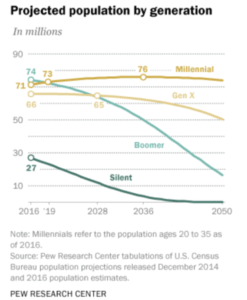Background Basics
Prevention has never been the strong suit of dentistry: “repair and replace” has been the industry’s bread and butter. This is expected, given that the economics of dentistry favors fixing rather than preventing. And economics is always the impetus — money is the superior driver in any for-profit business model. Dentists and their groups do what makes money, and prevention doesn’t make money. In business, you get what you measure, and you measure what’s deemed important. There are no KPIs for prevention in dental practice. What does that say about prevention? There are dental codes for prevention, but they don’t measure performance, and they don’t measure outcome. Millennials are the largest segment of the population at 92 million, far outnumbering other generations by as much as 30 million.
Millennials have the lowest frequency of dental visits, mainly due to cost and fear. And their oral hygiene is abysmal.
One-third of millennials only brush their teeth once a day
For some millennials, morning breath may last for more than just the morning.
That’s because, according to new research, many young Americans are failing to regularly clean their teeth.
A new study into the dental hygiene habits of 2,000 Americans found three in ten millennials studied only brush their teeth once a day.
There is a huge problem is on the horizon. What is dentistry going to do about it?
Currently, access to proper dental care is limited to 64 percent of the U.S. population. There is still more demand than supply from generations other than millennials who have been enculturated to care for their dental health. But dentistry needs to realize that this type of dental consumer is becoming more scarce.

The above graph clearly demonstrates that the number of current dental consumers is declining, and will continue to decline. To assume their replacements will want what these generations wanted is simply unwise. The millennial generation is taking the place of previous generations, and they are a generation that hasn’t been indoctrinated into seeing the dentist on a routine basis — let alone practicing proper brushing and flossing.
Millennials won’t be strong earners for years, if at all. And with the cost of dental work on the rise, what will this group do? Many millennials don’t have jobs with dental benefits, and many have had to find employment in the unreliable “gig” economy.
Now add to all this the pressures that are building to address oral inflammation, improve access, decrease costs, integrate with primary care, and in my view, a dental disaster awaits as millennials age.
Now What?
Unaddressed problems that directly inflate healthcare costs will force outside entities to impose changes on dentistry: government, employers, and insurance companies are going to demand that dentistry address this issue as it becomes more costly.
As millennials age, they will begin to have significant oral issues that they can’t pay for, along with chronic systemic issues that arise in the middle years, which are exacerbated by dental disease.
Greater volume of disease, decreasing access, increasing costs, greater demand than available supply, an unschooled majority and unappreciative market, increasing pressure on healthcare costs for chronic diseases: put them all together and what do you have? A disaster in the making.
- Author’s Notes: I am not in charge, but if I were, I would first secure some solid investors. Millennials are a market of 92 million. They have an unmet need. I’d ask the investors to invest their money in a group of top-flight entrepreneurs and thought-leaders who see the opportunity offered by this growing dental problem in this market.
- I am open to calls from professional organizations, suppliers, insurance companies, or equity partners. In our digital world, figuring this out is very doable. You don’t need too many dentists at $150 to $200 an hour to deliver a whole lot of prevention. Medical urgent-care centers don’t have too many physicians, and they are doing extremely well.
— Marc



